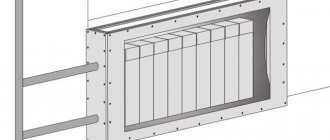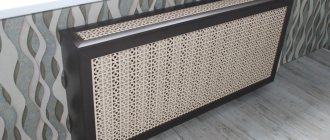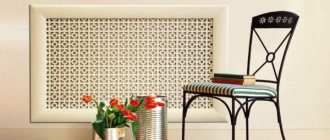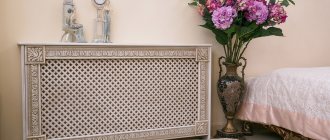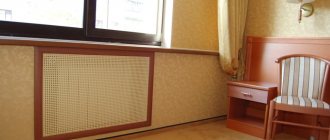Factory options or the best way to close heating radiators in an apartment or house
Modern industrial decorative grilles fit well into a residential interior, while simultaneously masking unsightly heating devices. The price of most copies is quite acceptable, all that remains is to make the right choice.
Hinged shields with top cover
Most often they are made of metal. Inexpensive products are made of painted iron, more expensive ones are made of stainless steel. The advantages of such panels include:
- Ease of installation - knowing how to cover a heating radiator with a decorative screen, the main work can be done with your own hands without the help of specialists.
- No obstacles to heat transfer - almost all products are manufactured with holes to improve convection. The shape of the holes is for every taste.
- Manufacturability - hinged panels are designed for one- or two-sided pipe connections.
Flat panels
The most common category, which is used to decorate heating devices located in niches. At the same time, such grilles play a decorative role in the interior of residential premises. In stores you can find a large assortment of screens with various designs, carvings and forgings, some of them can be compared to works of art.
Made of wood
Such false panels are ideal for any interior. If you have experience assembling at least small gazebos for your summer cottage, then the problem of how to hide the battery with your own hands does not exist for you. Products can also be made to order, in some carpentry workshop.
Wooden structures will help to withstand the elegant component of country style or all the rigor of classicism. When thinking about the topic of how to cover heating radiators in your own apartment, it is worth remembering the cost of handmade individual work - it is several times higher than consumer goods copies.
And yet, deformation of the wood due to temperature changes and humidity fluctuations cannot be ruled out. You can avoid such consequences only by purchasing a product made from high-quality wood.
Made of metal
Such fences attract, first of all, their affordability. The design component of such products is quite primitive, which is why they have a low price. However, despite this, they perform their function fully.
The panel is made of a thin sheet of metal, which can be painted in any color. More expensive specimens are made of stainless steel; their appearance is aesthetic and elegant.
Made of plastic
Taking into account the affordability of plastic products, you should not count on their durability. Moreover, not all of them meet the standards, as a result of which, when heated, they can release a bunch of harmful substances
Box screens
You can find out how to hide a battery in a room from photos of similar interiors. However, even modern heating devices do not always correspond to the design concept of the room. Then you have to completely isolate them “out of sight.” Box-shaped grilles are classified according to the type of material from which they are made.
MDF screens
One of the most common options for decorating heating appliances. Craftsmen who know how to carefully cover a heating radiator with a screen insist on this particular material. The MDF structure is not as difficult to maintain as wood, and is easy to install with your own hands.
An important advantage of such products is that their cost is 50-70 percent less than wooden ones. And this with characteristics that are not inferior to analogues made from natural wood.
Glass panels
The glass screen looks very aesthetically pleasing and can easily complement the stylish design of any room, including a corporate building. Depending on the appearance, glass panels are divided into:
- Matte.
- Transparent.
- Plainly colored.
- With unique photo printing.
Of course, the glass structure is fragile, so manufacturers produce samples with a thickness of at least 6 mm. For greater safety, you can buy tempered glass; it combines mechanical strength and heat resistance. Even if the panel manages to break, the fragments will be small and have blunt edges.
Kitchen along the window - no big deal!
An eternal problem is lack of space. Especially in the kitchens of old houses, where this room was not given enough space and most of them today are from 6 to 9 squares, which is very small. Once you look at a photo of such a room, you immediately wonder how to properly arrange it so as not to reduce the space and accommodate everything you need.
Some people solve this problem with square footage by combining several rooms or making a kitchen-studio, that is, a separate corner for cooking and a living or dining area. This is a fairly good option, but not everyone agrees, especially if the apartment is one-room. On the one hand, the kitchen automatically becomes visually larger, and on the other, you get the feeling of sleeping in the dining room.
When may it be necessary to install a grille in a window sill?
Modern technologies require the introduction of innovative solutions to improve the functionality of window systems, the efficiency of heating radiators, and improve visual design. A grille is installed in the window sill to normalize the circulation of air masses and eliminate condensation.
The need for ventilation may arise in the following cases:
- Planning for the installation of wide window sills covering the radiators. The heater will not distribute air properly. Condensation will begin to collect. The room will always be slightly cool and damp. It is enough to install a decorative grille to restore functionality to the equipment without violating the design concept.
- Incorrectly installed double-glazed windows, which leads to frequent fogging of the glass. Of course, a visit from a specialist from the company from which the PVC windows were ordered will ease the situation. But this is only relevant when the warranty service is valid. In other cases, it is more profitable to install a ventilation system.
- Plugging the holes of an already installed grille. This negatively affects air circulation, microclimate, and comfort in the room.
- Installing a countertop and creating a work area (for example, in the kitchen) near the window. In this case, you cannot do without ventilation built-in accessories.
A grille in the window sill often solves all problems. If there is no effect, we recommend considering other factors in the formation of condensation - poor-quality double-glazed windows, frequent watering of flowers, sudden heating of the room and ventilation.
Sink under the window
This layout option allows the housewife to admire the view from the window and also masks the radiators in the room. When placing a sink next to a window, you need to carefully consider the details before starting installation.
On the island there is a hob and a cooking area. The right overhang of the furniture structure can be used as a small bar counter.
Country style kitchen with island and work area near the window
Choose a compact mixer, otherwise the tap will interfere with opening the frames. It is better to purchase a model in which the water flow is directed downward so that moisture does not fall on the windowsill.
Minimalist corner kitchen with black countertop
Roller blinds are a color accent in this interior. They do not take up much space and cover the opening from the sun, if necessary.
Bright roller blinds in a country style kitchen
U-shaped set with a sink near the window opening. In order to wash dishes comfortably, a recess for the feet was made in the basement. The faucet with a high spout does not interfere with the opening of the frame, due to the sliding glass system.
White U-shaped kitchen with sink near the window
An additional lamp was installed above the sink, which is useful only at night.
Minimalism in a corner set with a sink opposite the window
Correct operation of the radiator in the countertop is ensured by special holes for ventilation.
Ventilation grilles for radiators in kitchen countertops
The upper tier of cabinets can be continued along the entire perimeter, or open shelves can be made if there is enough storage space.
Sink and work surface near the window in the corner kitchen
Ventilation grilles for window sills: advantages and disadvantages
This is a rare case when no flaws can be found. As for the advantages, let's try to list them:
- improving air circulation, heat exchange and, as a result, the microclimate of the room;
- installation is quite simple, any home craftsman can handle it. No special skills are required for this;
- installation is carried out on any surface under which the heating radiator is installed, be it a window sill or a tabletop;
- maintenance is simple - you just need to periodically wipe off the dust;
- The range of products on Russian shelves today is so wide that it allows you to choose a grille to suit any, even the most sophisticated interior.
Important! Before purchasing a window sill ventilation grill, there are many options to consider. It should be in harmony with the design of the room, not conspicuous
Otherwise, after installation, the home technician will be very disappointed with the result. It is not a fact that based on the cut-out dimensions it will be possible to select a product of a different color.
Another consequence of the lack of proper heat exchange
Types of grilles for heating radiators
Types of grilles
Regardless of the material, grilles for heating radiators can be made in different ways. There are several types of manufacturing that differ from each other and have different purposes. The choice of screen type depends on the installation method of the radiators themselves, the interior design and, accordingly, the functionality. It is also worth noting that depending on the complexity of the design, the cost will also change; the more complex the mechanism, the higher the price.
Flat screens. This kind of grille is used to decorate radiators installed in a niche. They can be made from any material used to make screens. The main advantage of this type of grating is its low cost, due to minimal material costs. Installation of such screens is often carried out on a rail fixed along the perimeter of the radiator, but installation on pre-prepared pins is also common; this method is ideal for installing glass grilles. This type of radiator grille is also called “facade”.
Hanging screens. There are two types of such designs. With or without a top cover. The presence of a top cover means maximum visual isolation of the battery and, accordingly, a more pleasant appearance. Installation of such screens is done by attaching the top cover to the radiator. Grilles without a top cover look less attractive, but increase air circulation, thereby increasing the efficiency of the radiator. They are mounted on special hooks that cling to the top of the radiators and are completely hidden.
Grate-box. These screens imply complete visual isolation of the radiator, including its side parts. From the point of view of heat transfer, this is not the best choice, but they are able to hide all the flaws of the battery and the pipes connected to it. Also among the disadvantages of this type of screens, it is worth noting the difficulty in installation and subsequent operation. Access to the radiator becomes more complicated and requires complete dismantling of the box, which creates inconvenience both when cleaning the room and during maintenance of the heating system as a whole.
Attached grille box. In most cases, such grilles do not have a rigid attachment to the radiator. They are made in the form of pieces of furniture, for example in the form of a chest of drawers or a small wardrobe. The installation of such gratings does not require special attention and is done by placing them against the wall. To increase air circulation and heat transfer, such screens have legs at the bottom and holes in the top cover.
It is worth noting that the main types of grilles for heating radiators are listed above. Often, they are made to order according to individual sketches, which is indispensable for creating a unique design and style of the room. The final result depends not only on the interior designers, but also on the choice of material for manufacturing. Structural design must include not only optimization for high heat output, but also heatsink accessibility.
Choosing a quality system
Before choosing a system, you need to keep the following criteria in mind:
Cost: It can vary widely as there are many companies producing inlet valves nowadays. All of them differ not only in functionality, but also in the materials used. It is worth noting that the cost of the valve itself reaches about half the cost of a whole window;
Installation area: a modern ventilation system can be installed not only in the window itself, but also through the adjacent wall. It is worth saying that the second method is much more expensive and more difficult than the first. In this regard, you should be very careful when choosing a ventilation valve;
Control method: all ventilation is manual or automatic. The first method requires a lot of control over all kinds of sensors. After all, not only humidity, but also air quality will depend on this. As for the second method, everything is very simple. The system fully automatically adjusts the room climate and regulates air humidity;
Sound insulation level: currently all systems have good noise protection. Due to this, the population will not experience discomfort during the operation of housing
It is worth noting that the supply valve should be selected in accordance with the requirements of the residents and the installed window;
Meets air exchange standards: any standard valve can produce fairly clean air that meets all modern standards;
Performance: You should also pay attention to the performance of the system. The fact is that the valve must provide a flow of fresh air even in unfavorable conditions
An example is condensation and its freezing at low temperatures. I would like to say that the formation of condensation depends on the temperature and humidity of the air.
Ventilation grilles for batteries on window sills of plastic windows
After installing plastic windows, a problem with condensation almost always arises. To solve this, you need to use ventilation grilles for window sills. This is a simple and convenient option designed to evenly distribute the warm air emanating from the radiator in the room.
After windows are installed, they are almost always equipped with window sills. To bring even more comfort and convenience, ventilation grilles for window sills were invented. These devices are responsible for circulating heated air, which is supplied by heating radiators to the window area.
A big problem is ventilation in the windowsill of plastic windows. After their installation, it is difficult to achieve natural air circulation. Typically, the heat coming from the radiators rises upward and then, cooling down, falls down the room. Convection grilles in the window sill perform the function of natural ventilation. With them, warm air will rise to the windows through the sill, which is much better.
Experts recommend installing grilles if there are wide window sills installed in the room. Their dimensions completely cover the heating radiators under the windows. After this, hot air does not enter the room correctly and is distributed there. For this reason, condensation forms and the room does not warm up well. A small decorative product will solve two problems at once, without violating the design intent.
Modern ventilation grilles differ in the way they are installed, controlled and in their location. They are made in different sizes, shapes, using different materials during the production process. It could be:
The shapes of the gratings come in different shapes, but the most common are rectangular. They come in the following sizes:
- 80x800 mm;
- 100x800 mm;
- 100x600 mm;
- 80x480 mm;
- 100x500 mm;
- 80x500 mm.
The gratings differ in the way they are adjusted and come in two types: unregulated and adjustable. The first type has fixed slats, while the second is equipped with slats that can be controlled. They tilt and can allow more or less air to pass through, directing air flow.
Products are divided according to the method of location relative to the window sill, for example, flush with the surface. They can also protrude relative to its surface. Convection grilles for window sills have different shapes of holes. Most often they are made in the form of slits. However, sometimes they are made with round perforations. If desired by the customer, they can be made in a decorative form or with an ornament.
Modern convection grilles in the window sill for radiators can be called an interior element that can decorate it. Almost all of them are aesthetically attractive models, presented in different colors and types of design. They are classified according to certain characteristics:
- design feature;
- type of material;
- color;
- dimensions;
- form;
- installation method.
The best option is aluminum models that are not afraid of UV and are affordable. Plastic window sill bars are considered the most inexpensive. However, in white they quickly lose their attractiveness and freshness when exposed to the sun and then break. The most durable and high-quality products can be called steel products. They are heavy and have a high price.
It is not recommended to place small objects on models with large holes to prevent them from falling through. If they are not used in any way, then you can choose products with larger perforations. Through this cross-section, more hot air will enter and a minimum of condensation will accumulate.
Color is of great importance, since a harmonious combination of products will fit perfectly into the interior. Some buyers like to have contrast, so they prefer an unusual combination of colors.
The black color of ventilation grilles is always suitable for window sills made of dark plastic or stone. They are also good for wooden structures. However, white products are considered the most popular, so they are ordered and purchased most often. A good option is silver and gray ventilation models. These shades are perfect for light and cool tones.
What causes condensation to form?
The concept of condensation refers to water that settles on window glass and frames due to excess presence in the air.
Most often, the occurrence of condensation is provoked by the following factors:
- operation of heating radiators;
- room temperatures are too high;
- making serious mistakes when installing windows in openings;
- lack of ventilation or incorrect operation of these products;
- installing a window sill whose width is too large and covers the radiators, resulting in water diffusion;
- high thermal conductivity of walls and window structures.
In most situations, the heating radiator is placed directly under the window sill tabletop, therefore, this element gets very hot and causes condensation. To get rid of this trouble, you need the correct installation of a ventilation grille that is built into the window sill.
More on the topic Supply valve for plastic windows
Installation Tips
To create high-quality ventilation, grilles can be installed indoors and outdoors.
When installing indoors, you need to pay attention to the location of the radiator. If it is located deep under the window sill, then the grille is mounted as close to the window as possible. And if the radiator protrudes beyond the window sill, then the grille should be installed above the radiator
And if the radiator protrudes beyond the window sill, then the grille should be installed above the radiator.
It is worth remembering that the wrong location for installing ventilation grilles will lead to them not performing their functions correctly.
For window sills made of plastic or wood, installation of ventilation grilles is quite simple. You can do it yourself. If the window sills are made of concrete, then it is better to use the services of specialists, since the installation process will require additional tools and experience working with this material.
For installation you will need a pencil or marker (to make markings), a grinder, a drill, as well as some heavy object to press down the grille. For plastic surfaces, glue is sometimes used.
When installing ventilation structures, there is no need to remove window sills. The procedure itself is quite simple and does not require special knowledge or skills. First, use a pencil to mark the installation site. Then the corresponding holes are cut out in the window sill using a grinder. Instead of a grinder, you can use a jigsaw.
The next step is to finish the surfaces of the cut holes. To do this, sandpaper is needed to clean the surfaces from irregularities and sharp protrusions. Next, the grate is inserted into the hole.
To fix the grille, you can use silicone. Also, the structure is often fixed using glue. To do this, before installing the grille, the edges of the holes should be coated with glue. After placing the grille in the hole, you need to remove excess glue, and then press the product with a heavy object for a while (until the glue dries).
It is worth noting that fixation with glue is not the best option. The fact is that when the need arises to remove the structure, it will have to be torn off from the surface. Therefore, it is better to ensure a tight fit of the structure using accurate measurements of the holes. If the edges of the hole are perfectly adjusted to the dimensions of the grille, then it will be tightly fixed. Moreover, if necessary, it can be easily pulled out.
Sometimes there are structures (mostly metal) that are fastened with bolts. This is another convenient fixation option.
Sources
- https://HomeMyHome.ru/ventilyacionnye-reshjotki-dlya-podokonnikov.html
- https://stroy-podskazka.ru/furnitura/podokonniki/ventilyacionnaya-reshetka/
- https://zamki-okna.ru/reshotki-podokonnik
- https://TopVentilyaciya.ru/ventilyaciya/elementy/reshyotka-dlya-podokonnika.html
- https://balkonka24.ru/ventilyatsionnye-reshetki-dlya-podokonnikov.html
Washing by the window: expert opinion
The standard location of the sink in a secluded corner of the kitchen is not always the best solution. If the kitchen is small, then such placement can narrow it even more, and besides, it will be very inconvenient for people with impressive height to wash dishes there. However, this is an excellent reason not to wash it and delegate the duties to someone more petite.
However, a non-standard location of the sink can radically transform the appearance of your kitchen and even make it much more functional. Kvartblog decided to consider the option where the sink is located right next to the window. Regina Urm , an expert on the “From Hand to Hand” portal, shared her comments with us on this matter .
Regina Urm is a designer with more than 10 years of experience in interior design. She graduated from MSTU (Moscow) with a degree in Interior Designer, and completed an internship and training at the PoliDesign Di Milano University in Milan. Now he is engaged in private practice in Moscow, working on the interiors of apartments, penthouses and cottages. Participant in various thematic TV programs on Channel One, TNT, NTV and the TV channel “Your Home”.
Installation Tips
To create high-quality ventilation, grilles can be installed indoors and outdoors.
When installing indoors, you need to pay attention to the location of the radiator. If it is located deep under the window sill, then the grille is mounted as close to the window as possible
And if the radiator protrudes beyond the window sill, then the grille should be installed above the radiator.
It is worth remembering that the wrong location for installing ventilation grilles will lead to them not performing their functions correctly.
For window sills made of plastic or wood, installation of ventilation grilles is quite simple. You can do it yourself. If the window sills are made of concrete, then it is better to use the services of specialists, since the installation process will require additional tools and experience working with this material.
For installation you will need a pencil or marker (to make markings), a grinder, a drill, as well as some heavy object to press down the grille. For plastic surfaces, glue is sometimes used.
When installing ventilation structures, there is no need to remove window sills. The procedure itself is quite simple and does not require special knowledge or skills. First, use a pencil to mark the installation site. Then the corresponding holes are cut out in the window sill using a grinder. Instead of a grinder, you can use a jigsaw.
The next step is to finish the surfaces of the cut holes. To do this, sandpaper is needed to clean the surfaces from irregularities and sharp protrusions. Next, the grate is inserted into the hole.
To fix the grille, you can use silicone. Also, the structure is often fixed using glue. To do this, before installing the grille, the edges of the holes should be coated with glue. After placing the grille in the hole, you need to remove excess glue, and then press the product with a heavy object for a while (until the glue dries).
It is worth noting that fixation with glue is not the best option. The fact is that when the need arises to remove the structure, it will have to be torn off from the surface. Therefore, it is better to ensure a tight fit of the structure using accurate measurements of the holes. If the edges of the hole are perfectly adjusted to the dimensions of the grille, then it will be tightly fixed. Moreover, if necessary, it can be easily pulled out.
Sometimes there are structures (mostly metal) that are fastened with bolts. This is another convenient fixation option.
For information on how to install a ventilation grille for a window sill, see below.
https://youtube.com/watch?v=sJ7dBaL9pTs
Important Requirements
The main task of each ventilation grille is to ensure the fastest possible rise of warm air coming from heating appliances to the windows through the window sills. Therefore, the location for it must be chosen as close as possible to the window structures.
If the window sill is large, the convection grille should be installed strictly above the heating radiators. It is important that the grille openings coincide with the dimensions of the upper section of the heating radiator.
The sections (holes) of the grating may differ in shape, but the value of the open section, that is, the total sum of the areas of all holes must be no less than 0.42 and no more than 0.60 l/s.
Such indicators are quite sufficient for effective ventilation, and besides, small parts cannot fall through such openings.
How to choose a radiator grille
Important!
- Today, consumers have a choice of the following types of battery panels:
- flat - involve decorating the heating element, which is located in a niche. They are suitable for different types of radiators;
- hinged - they are a lattice and are suitable for batteries, which are located in a niche under the window sill;
- wall mounted with a lid - designed for cast iron products that protrude slightly above the plane of the wall;
- boxes - completely cover the battery, but have many holes for ventilation.
Wooden panels are not suitable for decorating converter-type heating elements. Metal products reduce the harmful effects of thermal radiation on humans without interfering with heat transfer. Plastic should not be exposed to high temperatures, otherwise it will go out of use very quickly.
To increase the heat transfer of the screen, it is necessary to cover it from the inside with black paint - it helps to better absorb thermal energy and transfer it to the room.
If the radiator is located under a window sill, or in the case where the decorative box is closed at the top, you can install an aerodynamic gutter - a canopy that will prevent heated air from stagnating under the horizontal ceiling.
It is easy to make from a piece of sheet steel or even cardboard covered with foil. It is located along the entire length of the radiator, attached to the wall in its upper part and ending under the edge of the window sill.
You can further increase the efficiency of the battery by venting into the room the heated air that inevitably accumulates between the outer surface of the radiator and the inner wall of the screen. This simple device, called a heat injector, can be made using the same material as for the visor.
Here two planes are used, which form a tapering nozzle along the entire length of the radiator. Thus, two narrow horizontal slits are formed at the top of the screen - from the first, warm air comes out from the top of the box, from the second - from the front.
There are many options offered for sale; there is plenty to choose from, if you take into account all the requirements that a decorative screen for a heating radiator must meet. And for people who are familiar first-hand with the secrets of home craftsmanship, it should not be difficult to independently produce this piece of furniture.
If gas is available, the most economical way to heat a private home is a double-circuit gas boiler.
Or, as an option, an electric boiler.
Metal screens
Products made from thin sheets of steel (from 0.5 to 1 mm) do not retain heat and transfer it well to the room. Due to the powder painting method, they do not fade or fade over time. A stainless steel screen with unusual perforation will cost much more. If the battery is not located in the bathroom and is not regularly wet, there is no point in installing such an expensive casing.
Where are they used? Most often they are used in apartments and educational institutions, less often in office premises. They look very harmonious in high-tech or techno interiors.
Advantages : long service life, practicality, resistance to drying out, heat and deformation. In addition, metal models are easy to install, unpretentious to use and inexpensive.
Cons : a ready-made metal grate is difficult to adjust to the desired size. If the battery is non-standard, we recommend making a custom-made screen, although this will be more expensive.
Price*: “Classic” model – from 230 to 520 rubles, single-section “Delta” screens – from 140 to 250 rubles. Stainless steel screens with unusual perforations are more expensive: if the radiator is not located in the bathroom and is not subject to constant wetness, there is no point in installing such expensive equipment.
You can learn more about such screens on the page
Installation stages and rules
You can install a ventilation grill with your own hands in a plastic or wooden window sill; installation in a concrete “board” will require much more experience and other tools. Otherwise, the grille is installed in a concrete window sill in exactly the same way.
Let's consider the nuances and stages of work for a plastic or wooden board and the same lattice. It is not necessary to remove the window sill to carry out the work. The direction of the slats (if the holes are slot-shaped and the slats are installed at an angle) should be towards the window.
A hole cut in the window sill for the ventilation grille
Tools you will need:
Marking tool (marker, pencil).
Jigsaw or grinder.
Glue for plastic (optional).
Any heavy object that can be used as a press (needed if the lattice will stick).
The diameter of the drill bit must be larger than the width of the jigsaw blade (so that it can fit into the drilled hole).
Useful tips
There are several important recommendations that will prevent condensation from occurring.
For wide window sills, installing ventilation grilles is a mandatory step. The grilles must be cleaned or replaced regularly to ensure proper air circulation.
Try to keep the number of plants in pots on windowsills to a minimum, as frequent watering promotes condensation.
If you are not confident in your abilities, it is better to entrust the installation of ventilation grilles to professionals.
Source: klivent.biz/ventilyaciya/reshetka-v-podokonnik.html
